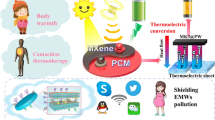Abstract
The role of two solvents, namely N,N-dimethylformamide (DMF) and N,N-dimethylacetamide (DMAc), on the dispersion of CNF in PVDF matrix has been studied when the composites are synthesized by non-solvent precipitation route followed by melt crystallization at 200 °C and quenching in water. The electrical conductivities of melt-crystallized PVDF–CNF, PVDF-7 wt% graphite-CNF nanocomposites synthesized using DMAc solvent are higher than that of composites synthesized using DMF solvent. Thermogravimetric analysis of PVDF-7 wt% graphite, PVDF-3 wt% CNF suggests that the onset temperature of thermal degradation of the composite synthesized using DMAc is 20 °C higher than that of the same composite synthesized by using DMF. The SEM analysis of cross section of melt-crystallized, water-quenched PVDF-3 wt% CNF clearly proves better dispersion of CNF when DMAc solvent is used. Structure development in the polymer when CNF is incorporated has been understood in terms of lattice mismatch theory. DSC analysis proves the nucleating ability of CNF when incorporated in the polymer matrix as crystallization temperature (Tc) is enhanced by 5 °C. At low frequency (40 Hz), the intergranular capacitance is more than two times higher for PVDF-3 wt% CNF composites synthesized by using DMAc solvent when compared to that of DMF employed composites. The enhancement of storage modulus at − 90 °C for PVDF-7 wt% CNF composites synthesized by using DMAc solvent when compared to that of DMF employed same composite supports better dispersion of CNF in PVDF matrix in the former case as revealed by DMA.












Similar content being viewed by others
References
Al-Saleh M (2015) Influence of conductive network structure on the emi shielding and electrical percolation of carbon nanotube/polymer nanocomposites. Synth Met 205:78–84
Ramanujam BTS, Annamalai PK (2017) In: Thakur VK, Thakur MK, Pappu A (eds) Hybrid polymer composite materials. Wood head publishing series in composite materials. Woodhead Publishing, Cambridge, pp 1–34
Raghava Reddy K, Hemavathi B, Balakrishna GR, Raghu AV, Naveen S, Shankar MV (2019) In: Pielichowski K, Majka TM (eds) Polymer composites with functionalized nanoparticles synthesis, properties and applications. Elsevier, Amsterdam, pp 357–379
Sui G, Jana S, Zhong WH, Fuqua MA, Ulven CA (2008) Dielectric properties and conductivity of carbon nanofiber/semi-crystalline polymer composites. Acta Mater 56(10):2381–2388
Puneta VD, Rana S, Yoo HJ, Chaurasia A, Mclesky JT Jr, Ramaswamy MS, Sahoo N, Cho JW (2017) Functionalization of carbon nanomaterials for advanced polymer nanocomposites: a comparison study between CNT and graphene. Prog Polym Sci 67:1–47
Raghava Reddy K, Jeong HM, Lee Y, Raghu AV (2010) Synthesis of MWCNTs-core/thiophene polymer-sheath composite nanocables by a cationic surfactant-assisted chemical oxidative polymerization and their structural properties. J Polym Sci A Polym Chem 48(7):1477–1484
Brink JVD (2007) Graphene from strength to strength. Nat Nanotechnol 2(4):199–201
Kim KT, Dao TD, Jeong HM, Anjanapura RV, Aminabhavi TM (2015) Graphene coated with alumina and its utilization as a thermal conductivity enhancer for alumina sphere/thermoplastic polyurethane composite. Mater Chem Phys 153:291–300
Zheng JJ, He A, Li J, Han CC (2007) Polymorphism control of poly(vinylidene fluoride) through electrospinning. Macromol Rapid Commun 28:2159–2162
Lovinger AJ (1983) Ferroelectric polymers. Science 220(4602):1115–1121
Kim GH, Hong SM, Seo Y (2009) Piezoelectric properties of poly(vinylidene fluoride) and carbon nanotube blends: β-phase development. Phys Chem Chem Phys 11:10506–10512
Vijayakumar RP, Khakar DV, Misra A (2010) Studies on α to β phase transformations in mechanically deformed PVDF films. J Appl Polym Sci 11:3491–3497
Chen S, Yao K, Tay FEH, Liow CL (2007) Ferroelectric poly(vinylidene fluoride) thin films on Si substrate with the β phase promoted by hydrated magnesium nitrate. J Appl Phys 102:104108-1–104108-7
Satapathy S, Pawar S, Gupta PK, Varma KBR (2011) Effect of annealing on phase transition in poly(vinylidene fluoride) films prepared using polar solvent. Bull Mater Sci 34(4):727–733
Bodkhe S, Rajesh PSM, Kamble S, Verma V (2014) Beta-phase enhancement in polyvinylidene fluoride through filler addition: comparing cellulose with carbon nanotubes and clay. J Polym Res 21:434
Wu L, Yuan W, Nakamura T, Atobe S, Hu N, Fukunaga H (2013) Enhancement of PVDF’s piezoelectricity by VGCF and MWNT. Adv Compos Mater 22:49–63
Bao SP, Liang GD, Tjong SC (2011) Effect of mechanical stretching on electrical conductivity and positive temperature coefficient characteristics of poly(vinylidene fluoride)/carbon nanofiber composites prepared by non-solvent precipitation. Carbon 49:1758–1768
Costa P, Silva J, Sencadas V, Costa CM, Hattum FWJ, Rocha JG, Lanceros Mendez S (2009) The effect of fibre concentration on the α to β-phase transformation, degree of crystallinity and electrical properties of vapour grown carbon nanofibre/poly(vinylidene fluoride) composites. Carbon 47:2590–2599
Mahato PK, Seal A, Garain S, Sen S (2015) Effect of fabrication technique on the crystalline phase and electrical properties of PVDF films. Mater Sci Pol 33(1):157–162
Yu S, Zheng W, Yu W, Zhang Y, Jiang Q, Zhao Z (2009) Formation mechanism of β-phase in PVDF/CNT composite prepared by the sonication method. Macromolecules 42:8870–8874
Ezquerra TA, Canalda JC, Sans A, Linares A (2014) On the electrical conductivity of PVDF composites with different carbon-based nanoadditives. Colloid Polym Sci 292(8):1989–1998
Ramanujam BTS, Radhakrishnan S, Deshpande SD (2017) Polyphenylene sulfide- expanded graphite nanocomposites: processing route dependent electrical percolation. J Thermoplast Compos Mater 30(12):1603–1614
Tran MM, Shaffer MSP, Bismarck A (2008) Manufacturing carbon nanotube/PVDF nanocomposite powders. Macromol Mater Eng 293:188–193
Saujanya C, Radhakrishnan S (2001) Structure development and properties of PET fibre filled PP composites. Polymer 42(10):4537–4548
http://colonialchemicals.com/uploads/Products/DMF/DMF_Tech.pdf, aventelfrance.com/product/download/27
Ramanujam BTS, Mahale RY, Radhakrishnan S (2010) Polyether sulfone- expanded graphite nanocomposites: charge transport and impedance characteristics. Compos Sci Technol 70:2033–2138
Acknowledgements
The authors thank Prof. S.W. Gosavi, Department of Physics, and University of Pune, for running dielectric measurements of few samples. This work did not receive funding from any funding agency.
Author information
Authors and Affiliations
Corresponding author
Additional information
Publisher's Note
Springer Nature remains neutral with regard to jurisdictional claims in published maps and institutional affiliations.
Rights and permissions
About this article
Cite this article
Ramanujam, B.T.S., Adhyapak, P.V., Radhakrishnan, S. et al. Effect of casting solvent on the structure development, electrical, thermal behavior of polyvinylidene fluoride (PVDF)–carbon nanofiber (CNF) conducting binary and hybrid nanocomposites. Polym. Bull. 78, 1735–1751 (2021). https://doi.org/10.1007/s00289-020-03176-6
Received:
Revised:
Accepted:
Published:
Issue Date:
DOI: https://doi.org/10.1007/s00289-020-03176-6




